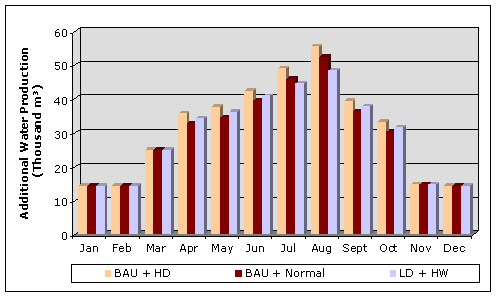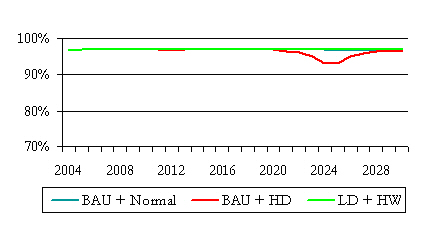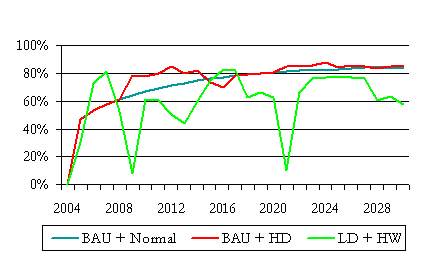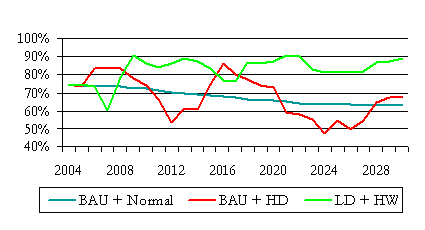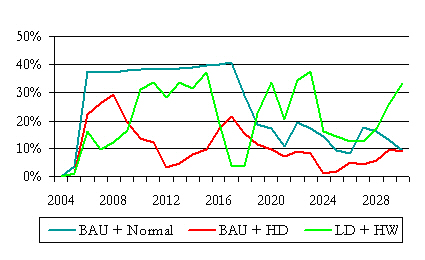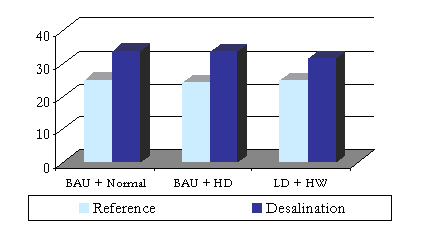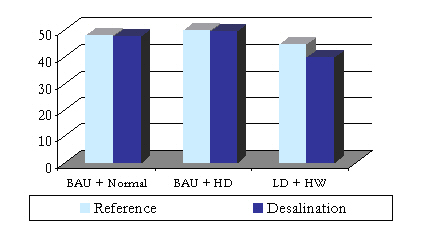
ISSUE 6 |
|||||||||||||||||||||||||||||||||||||||||||||||||||||
|
|
||||||||||||||||||||||||||||||||||||||||||||||||||||
Option results |
|||||||||||||||||||||||||||||||||||||||||||||||||||||
|
Figure 1 presents the water produced from the four units in the BAU + Normal scenario. Although desalination in all four areas is used as a primary resource, units operate in full capacity only during August. During the winter operation falls to approximately 25 % of the installed capacity. Figure 1. Water production from the four new desalination units (BAU + Normal scenario) Although desalination in all four areas is used as a primary resource, units operate in full capacity only during August. During the winter operation falls to approximately 25 % of the installed capacity, as presented in Figure 2.
Figure 2. Monthly water production from the new desalination
plants |
|||||||||||||||||||||||||||||||||||||||||||||||||||||
|
|
|||||||||||||||||||||||||||||||||||||||||||||||||||||
Effectiveness |
|||||||||||||||||||||||||||||||||||||||||||||||||||||
|
Desalination is the structural solution that performs the best among all examined. Due to the design specification, domestic demand coverage does not fall below 95% with the exception of a dry period in the BAU+HD scenario, where the effectiveness to domestic use is approximately equal to 92% (Figure 3). Figure 3. Percent demand coverage effectiveness of Desalination to Domestic use The domestic deficit improvement with respect to each reference scenario is subject to the high hydrological variations; improvements are lower under the LD+HW scenario where due to high water availability and decreasing demand trends, the domestic deficit is lower. Under the two other scenarios domestic deficit improvements can reach even 80% with respect to the reference scenario (Figure 4). Figure 4. Percent Improvement of deficit in Domestic use with respect to the reference scenarios (Desalination option) The domestic use relies more on desalination, and the smaller dependency to groundwater resources helps in the alleviation of irrigation shortages (Figure 5). Desalination units have been designed so as to meet domestic deficits, and not to completely substitute the use of groundwater resources; therefore, irrigation deficit improvements decrease as domestic demand increases and domestic use dependence on groundwater resources becomes higher (Figure 6). Figure 5. Percent demand coverage effectiveness of Desalination to Irrigation use
Figure 6. Percent Improvement of deficit in Irrigation use |
|||||||||||||||||||||||||||||||||||||||||||||||||||||
Direct and Environmental Costs |
|||||||||||||||||||||||||||||||||||||||||||||||||||||
|
Despite the observed improvement and the recent technological advances, which lower energy consumption and costs, desalination remains a very expensive solution. Figure 7 presents the present value of direct cost between the three scenarios that were examined. In all cases an at least 30% increase of costs is anticipated if a strategy shall predominantly rely on desalination. A combination of the option with other, mostly non-structural solutions should therefore be preferred in an effort to limit the required capacity, and avoid incurring very high additional costs to consumers.
Figure 7. Total direct cost difference of the Desalination option The Environmental costs, presented in Figure 8, are once again almost constant within the BAU+Normal scenario, and within the BAU+HD scenario, for the reference case and the addition of Desalination. Under the LD+HW scenario however, the environmental cost is significantly reduced where Desalination is introduced, due to the reduction in groundwater abstractions that would be otherwise needed for the provision of drinking water.
Figure 8. Total environmental cost difference of the Desalination option |
|||||||||||||||||||||||||||||||||||||||||||||||||||||

